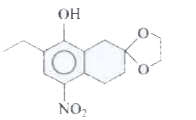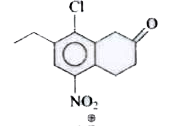Predict the product of reaction of
sulfonation with benzaldehyde.
To predict the product of the reaction of sulfonation with benzaldehyde, we can follow these steps:
Step 1: Identify the structure of benzaldehyde
Benzaldehyde is an aromatic compound with the formula C6H5CHO. It consists of a benzene ring (C6H5) with a formyl group (-CHO) attached to it.
Step 2: Understand the effect of the aldehyde group
The -CHO group is an electron-withdrawing group due to its -M (minus mesomeric) effect. This means that it pulls electron density away from the benzene ring, making it less nucleophilic. As a result, it influences the position where electrophiles will add to the aromatic ring.
Step 3: Determine the directing effect of the -CHO group
Because the -CHO group is an electron-withdrawing group, it directs incoming electrophiles to the meta position of the benzene ring. The meta position is the position that is one carbon away from the substituent, specifically the 1,3-positions relative to the -CHO group.
Step 4: Identify the electrophile in sulfonation
In the sulfonation reaction, the electrophile is the sulfonyl group (SO3H). This can be generated from sulfuric acid (H2SO4) or oleum (H2S2O7).
Step 5: Predict the product of the reaction
Since the -CHO group directs the electrophile to the meta position, the sulfonyl group (SO3H) will be added to the benzene ring at the meta position relative to the -CHO group. Therefore, the product of the reaction will be meta-sulfobenzaldehyde.
Final Product
The final product of the sulfonation of benzaldehyde is meta-sulfobenzaldehyde.
---
Benzaldehyde is an aromatic compound with the formula C6H5CHO. It consists of a benzene ring (C6H5) with a formyl group (-CHO) attached to it.
The -CHO group is an electron-withdrawing group due to its -M (minus mesomeric) effect. This means that it pulls electron density away from the benzene ring, making it less nucleophilic. As a result, it influences the position where electrophiles will add to the aromatic ring.
Because the -CHO group is an electron-withdrawing group, it directs incoming electrophiles to the meta position of the benzene ring. The meta position is the position that is one carbon away from the substituent, specifically the 1,3-positions relative to the -CHO group.
In the sulfonation reaction, the electrophile is the sulfonyl group (SO3H). This can be generated from sulfuric acid (H2SO4) or oleum (H2S2O7).
Since the -CHO group directs the electrophile to the meta position, the sulfonyl group (SO3H) will be added to the benzene ring at the meta position relative to the -CHO group. Therefore, the product of the reaction will be meta-sulfobenzaldehyde.
The final product of the sulfonation of benzaldehyde is meta-sulfobenzaldehyde.
Topper's Solved these Questions
- ALDEHYDES, KETONES AND CARBOXYLIC ACIDSBOOK - ICSECHAPTER - ALDEHYDES, KETONES AND CARBOXYLIC ACIDSEXERCISE - EXERCISE (PART-I OBJECTIVE QUESTIONS)
303 Videos
- ALDEHYDES, KETONES AND CARBOXYLIC ACIDSBOOK - ICSECHAPTER - ALDEHYDES, KETONES AND CARBOXYLIC ACIDSEXERCISE - EXERCISE (PART-II DESCRIPTIVE QUESTIONS) (VERY SHORT QUESTIONS)
282 Videos
- ALCOHOLS, PHENOLS AND ETHERS BOOK - ICSECHAPTER - ALCOHOLS, PHENOLS AND ETHERS EXERCISE - ISC EXAMINATION QUESTIONS
25 Videos
- APPENDIX II ( TYPICAL CONVERSIONS)BOOK - ICSECHAPTER - APPENDIX II ( TYPICAL CONVERSIONS)EXERCISE - AROMATIC CONVERSIONS
98 Videos
Similar Questions
Knowledge Check
Predict the major product of reaction:
 A
A B
B C
C D
D
Predict the product of reaction of
acetone with KMnO4.
View SolutionPredict the product of reaction of
acetone with KMnO4.
View SolutionPredict the product of reaction of
ozonolysis of ethylene.
View SolutionPredict the product of reaction of
ozonolysis of ethylene.
View SolutionPredict the product of reaction of
ozonolysis of ethylene.
View SolutionPredict the product of reaction of
acetone with Tollen's reagent.
View SolutionPredict the product of reaction of
acetone with Tollen's reagent.
View Solution

